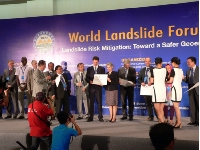Institute of Rock Mechanics and Structure ASCR has become a Worldwide Centre of Excellence
The scientific teams of the Academy of Sciences of the CR and Charles University have received significant awards for their results so far in long-term joint research of landslides. The Institute of Rock Mechanics and Structure (ÚSMH) of the ASCR, v. v. i, along with the Faculty of Science of CU obtained the title of a Worldwide Centre of Excellence for Research of the Risks of Landslides in Beijing in June of this year.
The certificate is valid for the period 2014–2017. The Czech Republic is thus now one of 15
such centres all over the world. “The aim of the activity of our centre is to observe in the long
term the different types of slope movements in various parts of the world and using new methods in
risk analysis to contribute to a reduction of the number of victims and damage caused each year by
landslides,” stated Director of the ÚSMH ASCR RNDr. Josef Stemberk, CSc. He added that he expects
close cooperation with the other centres particularly in Slovenia and Italy.
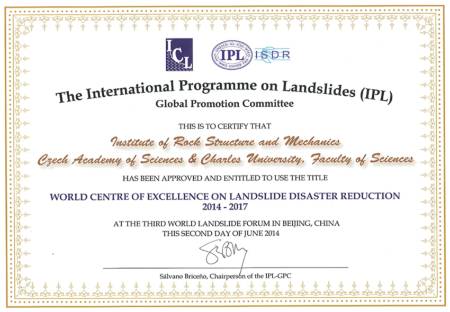
The certificate, which is awarded by the International Consortium on Landslides along with
UNESCO, was received personally from General Director of UNESCO Irina Boková by doc. RNDr. Vít
Vilímek, CSc., from the Faculty of Science of CU. “The title itself is not connected with a
financial reward, but obtaining it allows our institution to deepen the existing successful
international research projects, connect to other globally important scientific centres or select
suitable contacts for the internships of our doctoral students and young scientific workers,“
explained doc. Vilímek. He mentioned that the new joint centre builds on a similar award, which the
Faculty of Science of CU received three years ago as the World Forum in Rome. “At the same time, it
is an evaluation of our long-term activity in the International Consortium on Landslides where we
are among the founding members,” he stressed.
Director of ÚSMH of the ASCR J. Stemberk stated that landslide research is focused on
the central Andes (particularly Peru), Central Asia, the Ethiopian Highlands, Central Europe and
Svalbard. He pointed out that it was the results of research in Svalbard can provide valuable data
on the evolution of slope deformations under the conditions of a changing climate. “They could be
particularly useful for mountain areas affected by the momentary retreat of glaciers, where you can
expect an increased incidence of various types of landslides,” he said. He added that the end of
July his research team is preparing a several-week-long expedition to Svalbard, where it will
continue in measuring movements on tectonic faults and in documentation of the large rock
avalanches. It is the fifth year already that research has been conducted there.
An important component of the centre is also the creation of a worldwide database of glacial
lakes, where there is a risk of the banks bursting accompanied by catastrophic floods in the valley
below. The results will serve not only to researchers but also to local authorities and businesses.
“They receive a recommendation which localities they should not settle and build, because the
greatest damages from flooding threaten there,” said doc. Vilímek. He added that the Research Team
of Geomorphology and Geodynamics is working on this database.
For further information, contact:
RNDr. Josef Stemberk, CSc.
Institute of Rock Mechanics and Structure ASCR, v.v.i.
Department of Engineering Geology, tel.: 266 009 318
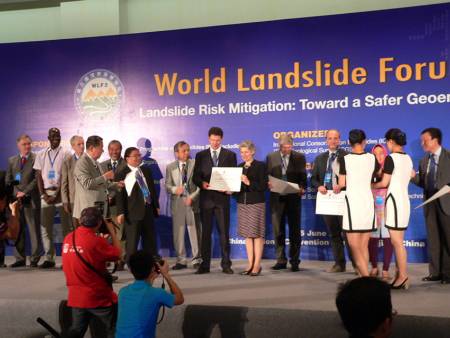
General Director of UNESCO Irina Boková hands the diploma to doc. V.
Vilímek in Beijing
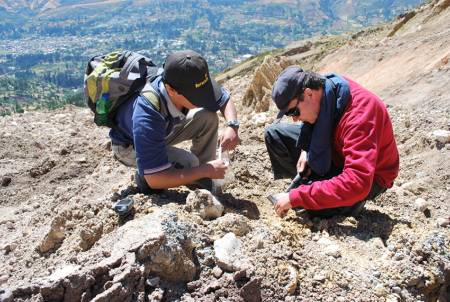
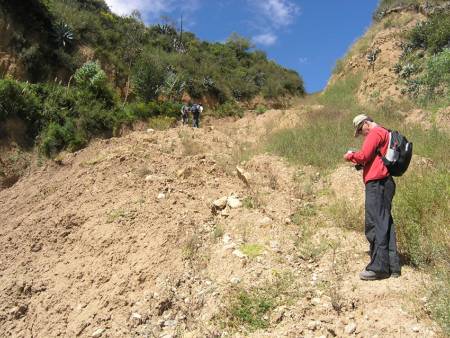
Rampac Grande, Cordillera Negra, Peru. Observing the development of
the landslide, which destroyed several houses and killed people in 2009. Field work from 2014 shows
that the landslide is still dangerous.
Prepared by: The Institute of Rock Mechanics and Structure ASCR
Photo: archive of the ÚSMH ASCR and FS CU
The Institute of Rock Mechanics and Structure ASCR, v. v. i., is a
workplace focused on the study of the structure and properties of rock environments, rocks, derived
materials and special composite materials. It investigates natural and induced phenomena and
processes acting on the behaviour, development and stability of rocks in their natural placement in
the Earth’s crust and a wide range of inorganic and organic materials both on site and created
under laboratory conditions. It applies advanced monitoring and laboratory methods of research with
the aim of formulating scientific knowledge and determining the conditions of their use in
practice.






